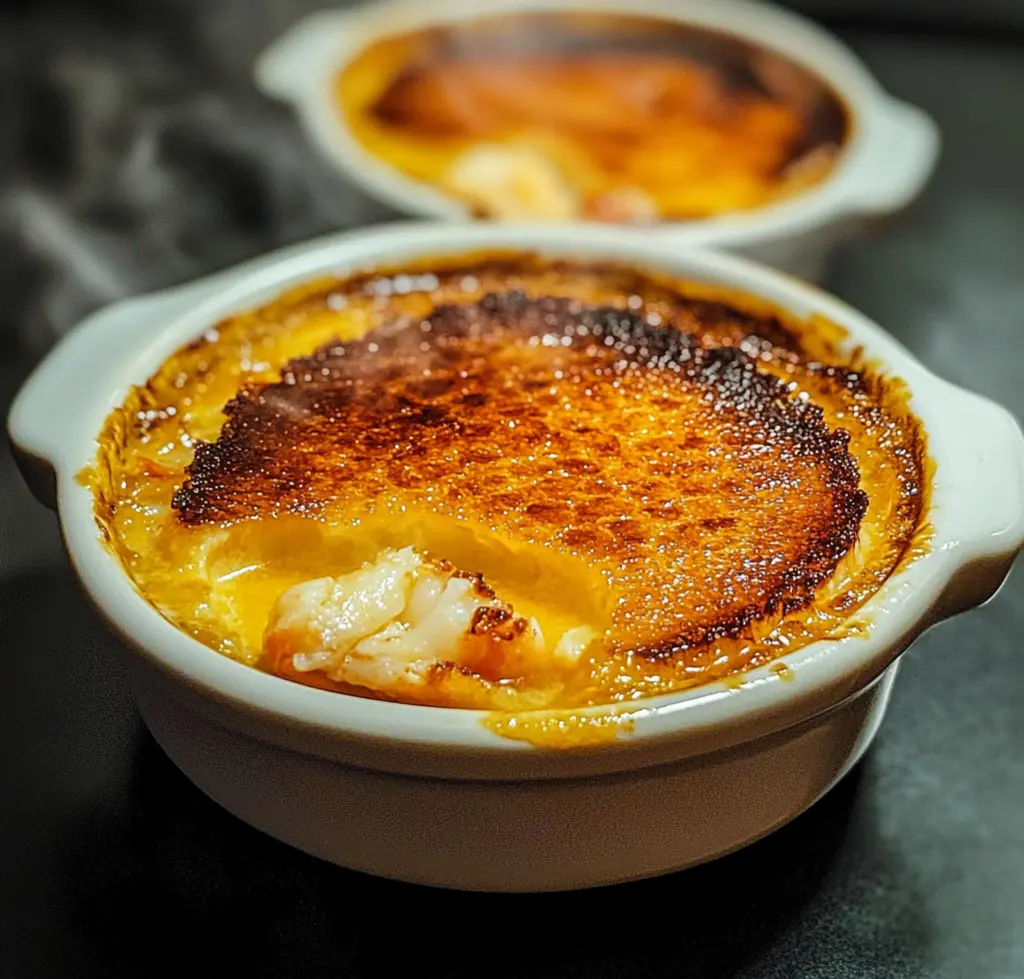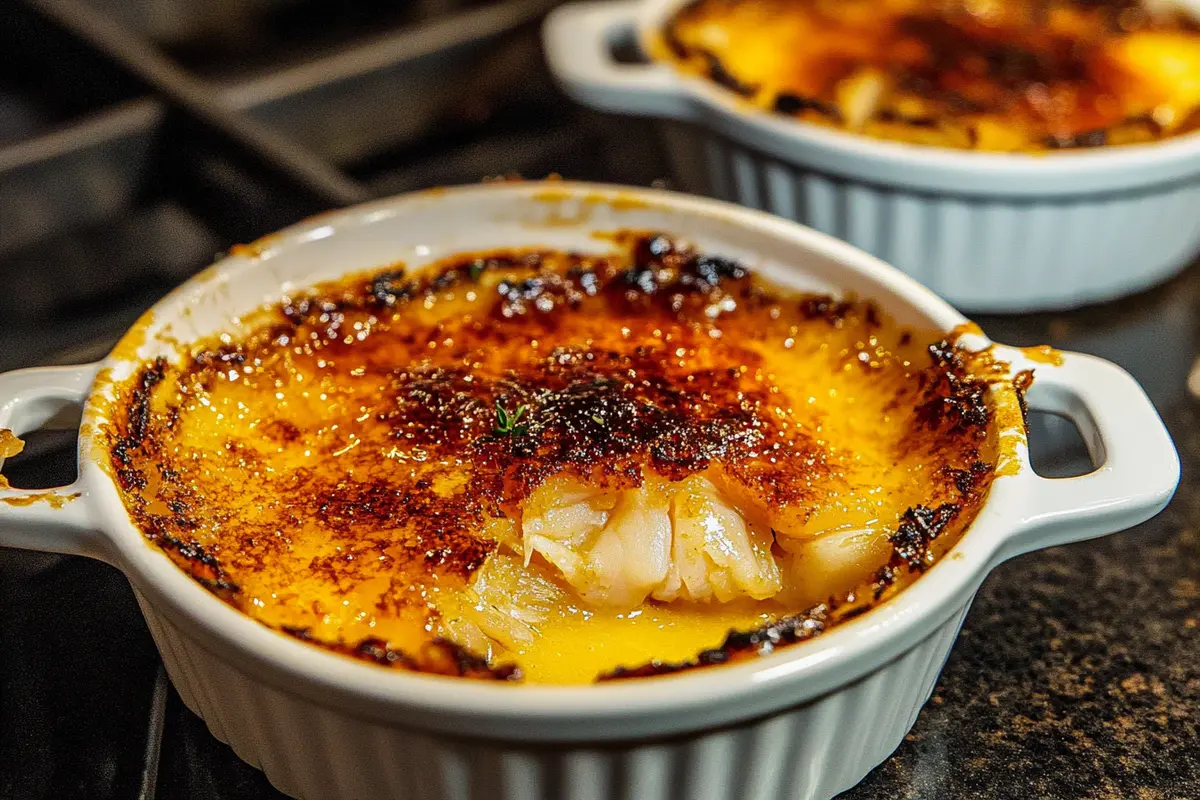Creating a crab brulee recipe isn’t just about cooking; rather, it’s about truly mastering the delicate balance of savory seafood with creamy textures and a perfectly caramelized topping. Indeed, this dish is a culinary masterpiece, as it seamlessly blends the luxurious richness of custard with the subtle yet delicate flavor of crab meat. Whether you’re preparing it for a special occasion or just indulging in a gourmet delight, every step matters.
In this article, you’ll discover everything—from the fascinating history of this dish and its step-by-step preparation to creative variations and expert tips to ensure absolute perfection. So, without further ado, let’s dive in!
Discovering the Exquisite Crab Brulee Recipe
The Origins and Evolution of Crab Brulee
Crab brulee, a fusion of French culinary finesse and coastal flavors, stands as a testament to creativity in the kitchen. Though its roots lie in the classic crème brûlée, chefs worldwide have added their twists, integrating fresh crab meat into the custard.
This dish has gradually evolved from fine-dining menus to cozy home kitchens, thereby symbolizing both indulgence and sophistication. Moreover, it seamlessly marries the creamy, silky consistency of custard with the unmistakable, bold taste of seafood, ultimately making it an enduring favorite for seafood lovers everywhere.
Why Crab Brulee is a Culinary Masterpiece
What truly sets the crab brulee recipe apart is its remarkable versatility. In fact, it’s not merely a dessert-inspired dish; rather, it’s a savory sensation that effortlessly bridges the gap between an elegant starter and a satisfying main course. Furthermore, the caramelized sugar topping adds a delightful crunch, which beautifully contrasts with the soft, creamy custard, ultimately creating an unforgettable texture that leaves a lasting impression.
Moreover, the integration of crab meat introduces a briny depth of flavor that complements the creaminess perfectly. It’s a dish that demands attention, both in preparation and presentation.
Stay tuned for the next section, where we’ll uncover the essential ingredients to create this luxurious seafood treat!
Ingredients and Preparation
Essential Ingredients for the Perfect Crab Brulee
Creating a flawless crab brulee recipe begins with sourcing the right ingredients. Quality matters here; after all, this dish is about harmonizing delicate flavors into a gourmet masterpiece. Below is a complete ingredient list to help you get started:
- Fresh Crab Meat (1 cup): The heart of this dish, bringing its signature sweet and savory seafood flavor.
- Heavy Cream (1 cup): Adds a rich, creamy texture to the custard.
- Egg Yolks (4 large): Essential for creating the silky, smooth custard base.
- Parmesan Cheese (2 tablespoons, grated): Enhances the savory notes.
- Shallots (1 tablespoon, finely minced): Provides a subtle sweetness and depth.
- Butter (1 tablespoon): Used for sautéing and flavor enhancement.
- Salt and Pepper (to taste): Balances and elevates the flavors.
- Granulated Sugar (2 tablespoons): For that iconic caramelized topping.
These ingredients work together to deliver a dish that’s as rich in taste as it is in presentation.
Selecting the Finest Crab Meat
To ensure the best flavor, selecting the right crab meat is key. Whenever possible, opt for fresh lump crab meat—it’s sweet, tender, and perfect for a dish like this. However, if fresh crab is unavailable, canned or frozen crab meat is a viable alternative.
When using canned crab, look for products labeled as “lump” or “jumbo lump,” as these contain larger, more flavorful pieces. Always rinse canned crab meat gently to remove any residual brine or preservatives before use. Fresh crab offers unmatched sweetness, but quality canned varieties can still shine when handled properly.
Complementary Components for Enhanced Flavor
While crab and custard are the stars of the show, a few additional ingredients can elevate your crab brulee recipe. Shallots bring a mild, aromatic sweetness, while Parmesan cheese deepens the savory profile of the dish. A dash of freshly ground black pepper adds a hint of spice that balances the custard’s creaminess.
Finally, don’t underestimate the role of salt in tying all these flavors together. Use it sparingly to enhance, not overpower, the natural sweetness of the crab.
Step-by-Step Preparation Guide for Crab Brulee
Making crab brulee may seem like a daunting task, but following these clear steps ensures success. From mixing the custard to perfecting the caramelized topping, every detail counts.

Crafting the Creamy Custard Base
Start by preheating your oven to 325°F (165°C). While the oven heats, focus on creating the custard:
- In a medium saucepan, heat the heavy cream over low heat until it’s warm but not boiling. Set it aside to cool slightly.
- In a mixing bowl, whisk the egg yolks until they’re smooth and pale in color. Slowly pour the warm cream into the yolks while whisking continuously. This prevents the eggs from curdling.
- Season the custard base with salt, pepper, and grated Parmesan cheese. Stir until fully incorporated.
At this stage, your custard base should not only be silky and smooth but also well-seasoned, perfectly ready to enhance and complement the natural, delicate flavors of the crab.
Incorporating Crab Meat into the Custard
To add the crab meat:
- In a small skillet, melt the butter over medium heat and sauté the minced shallots until they’re soft and fragrant.
- Gently fold the sautéed shallots and prepared crab meat into the custard base, ensuring the ingredients are evenly distributed without overmixing. Additionally, take extra care not to break apart the crab lumps, as their texture plays a crucial role in the dish’s overall charm and appeal.
- Next, carefully divide the mixture evenly into ramekins, filling each about three-quarters full to allow room for expansion while baking. This step ensures consistent portion sizes and even cooking for each serving.
Once filled, place the ramekins into a deep baking dish. Add enough hot water to the dish to create a water bath, reaching halfway up the sides of the ramekins. Bake in the preheated oven for 35–40 minutes, or until the custard is set but still slightly jiggly in the center.
The next steps? Perfecting the caramelized topping and serving this delightful dish with flair!
Cooking Techniques
Mastering the Baking Process for Crab Brulee
The baking process is truly the stage where the crab brulee recipe fully transforms into a silky, decadent masterpiece. In fact, precision and patience are your absolute best friends here. By baking the custard gently and evenly, you can ensure that its texture remains smooth and luscious, without ever becoming grainy or overcooked.
Start by setting your oven to 325°F (165°C). While it preheats, place your prepared ramekins in a baking dish. Once the custard mixture is ready, creating a controlled baking environment is key to achieving perfect consistency.
Importance of the Water Bath Method
A water bath, also called a “bain-marie,” is essential for even cooking. By surrounding the ramekins with water, you regulate the heat, preventing the custard from cooking too quickly or unevenly.
- Fill the baking dish with hot water, ensuring it reaches halfway up the sides of the ramekins.
- Carefully transfer the dish to the oven to avoid splashing water into the custard.
This method not only protects the custard from direct heat but also ensures that it cooks gently and sets beautifully, all while preventing any risk of curdling or cracking. Additionally, it helps maintain the smooth, creamy texture that is essential for achieving the perfect crab brulee recipe.
Achieving the Ideal Custard Consistency
Custard that’s too runny or overly firm can ruin the crab brulee recipe. To check for doneness:
- Gently jiggle a ramekin. The custard should appear set around the edges but still wobble slightly in the center.
- Avoid overbaking, as this can result in a grainy texture.
If the custard seems undercooked after the recommended time, give it a few extra minutes in the oven, checking frequently to avoid overdoing it.
Caramelizing the Sugar Topping to Perfection
The caramelized sugar topping is what elevates crab brulee from delicious to divine. This crispy layer provides a delightful contrast to the creamy custard underneath, creating an unforgettable textural experience.
Utilizing a Kitchen Torch vs. Broiler Method
There are two primary methods for caramelizing the sugar topping: using a kitchen torch or the oven broiler.
- Kitchen Torch: Ideal for precise control, a torch allows you to caramelize the sugar evenly without heating the custard below. Move the flame in a circular motion to achieve a golden, bubbly crust.
- Broiler Method: For those without a torch, the broiler works well. Place the ramekins on a baking sheet and position them close to the broiler’s heat. Keep a watchful eye, as sugar can burn quickly under intense heat.
While the torch method offers finesse, the broiler is a practical alternative. Both methods can deliver stunning results when done correctly.
Tips for a Crisp and Even Caramelized Layer
Achieving the perfect topping requires a few simple tricks:
- Use Fine Sugar: Granulated sugar works best for an even caramelization. Coarse sugars may melt unevenly.
- Spread Sugar Evenly: Sprinkle a thin, even layer over the custard’s surface to avoid clumps or patches.
- Monitor Closely: Whether using a torch or broiler, keep a close watch to prevent burning. Remove the ramekins as soon as the sugar reaches a golden brown hue.
Now your crab brulee is ready for its final touch! The topping adds not only a textural element but also a delightful sweetness that perfectly balances the savory custard.
Stay tuned for the next part, where we explore serving suggestions and pairings to make your dish truly shine.
Serving Suggestions and Pairings
Presenting Crab Brulee with Elegance
A beautifully presented crab brulee recipe can transform your dish into an unforgettable dining experience. The ramekins themselves offer a polished look, but the way you plate and garnish can elevate the visual appeal further.
Place each ramekin on a small plate and pair it with a polished dessert spoon or seafood fork. For an extra touch of sophistication, use a napkin-lined saucer to frame the ramekin and prevent it from sliding. Keeping the plating simple yet refined ensures the crab brulee remains the star of the show.
Garnishes to Enhance Visual Appeal
Garnishes are the cherry on top—literally! For a savory dish like crab brulee, opt for fresh and complementary garnishes:
- Fresh Herbs: A sprig of parsley, dill, or microgreens adds a pop of color.
- Lemon Zest: Thin shavings of lemon peel lend a hint of brightness while enhancing the seafood flavors.
- Edible Flowers: For an elegant touch, edible flowers like nasturtiums or pansies can make the presentation stunning.
The key is moderation. Too many garnishes can overwhelm the dish visually and detract from its simplicity.
Ideal Accompaniments for a Balanced Meal
Crab brulee pairs wonderfully with light, complementary sides. Here are some ideas to complete your meal:
- Mixed Greens Salad: A crisp salad with vinaigrette offers a refreshing contrast to the creamy custard.
- Crusty Bread or Crackers: The crunch of bread or artisanal crackers works well to balance the soft texture of the brulee.
- Seasonal Vegetables: Lightly steamed or roasted veggies, such as asparagus or zucchini, add balance without overpowering the dish.
Each of these accompaniments ensures a harmonious dining experience while letting the brulee shine.
Alternative Pairings for Crab Brulee
To accommodate diverse preferences and ensure inclusivity, there are excellent options to accompany your crab brulee recipe. These beverages offer refreshing and complementary flavors:
- Fresh Citrus-Infused Water: Chilled water infused with slices of lemon, lime, or orange for a bright and zesty touch.
- Iced Herbal Tea: A light, refreshing herbal tea with subtle natural sweeteners, such as honey or agave.
- Refreshing Grape Juice Spritz: Chilled grape juice with a splash of soda water and a garnish of fresh mint leaves.
These pairings ensure a delightful dining experience while keeping the focus on the star of the meal: your beautifully crafted crab brulee.
Variations and Dietary Considerations
Creative Variations of the Classic Crab Brulee Recipe
The beauty of the crab brulee recipe lies in its adaptability. While the classic version is delicious, adding your personal touch can elevate it to something uniquely yours. Here are some exciting ways to make it your own:
- Smoky Crab Brulee: Add a hint of smoked paprika to the custard for a subtle smoky flavor that enhances the natural sweetness of the crab.
- Spicy Kick: A dash of cayenne or a sprinkle of chili flakes brings a lively heat that contrasts beautifully with the creamy custard.
- Cheesy Delight: Experiment with different cheeses like Gruyère or sharp cheddar for a bolder, more pronounced flavor.
Incorporating Different Seafood Options
If crab isn’t your first choice or you want to explore other seafood, try these variations:
- Lobster Brulee: Swap crab meat for lobster for an equally indulgent, slightly firmer texture.
- Shrimp Brulee: Chopped, cooked shrimp adds a fresh and tender bite.
- Scallop Medley: Minced scallops bring a delicate sweetness that pairs well with the custard.
Feel free to mix seafood for a medley of flavors and textures.
Flavor Infusions with Herbs and Spices
Enhancing your crab brulee with herbs and spices adds depth and complexity:
- Herbal Notes: Add fresh thyme, tarragon, or chives to the custard for a fragrant twist.
- Exotic Spice Blends: Try curry powder, saffron, or a hint of nutmeg for a touch of warmth and uniqueness.
These small additions can completely transform the dish while keeping its essence intact.
Adapting the Recipe for Dietary Preferences
Making the crab brulee recipe inclusive ensures everyone can enjoy it. Simple adjustments can accommodate various dietary needs without compromising flavor.
Dairy-Free and Gluten-Free Alternatives
For those avoiding dairy or gluten:
- Dairy-Free Options: Replace heavy cream with coconut cream or unsweetened cashew milk for a rich, creamy texture.
- Gluten-Free Assurance: The classic recipe is naturally gluten-free, but double-check your seasoning and crab sources to avoid cross-contamination.
These alternatives maintain the dish’s signature creaminess and taste.
Adjusting for Low-Sodium Diets
If you’re watching your salt intake:
- Opt for unsalted butter and low-sodium Parmesan cheese.
- Rely on fresh herbs and spices like garlic powder, black pepper, or paprika to add flavor without extra sodium.
These changes keep the dish flavorful while making it heart-healthy.
Frequently Asked Questions (FAQs)
Let’s address some common questions about making and enjoying crab brulee:
What’s the difference between crème brûlée and custard?
Crème brûlée is a custard dessert with a caramelized sugar topping, while custard alone is a creamy base without the sugar layer.
What does crème brûlée taste like?
It’s rich, creamy, and slightly sweet, with a crispy caramelized sugar topping that adds texture and depth.
Can I make crème brûlée without ramekins?
Yes, you can use heat-safe glass jars or shallow ceramic bowls as alternatives to ramekins.
How to make a crème brûlée top?
Sprinkle an even layer of sugar over the custard and use a kitchen torch or broiler to caramelize it until golden and crispy.
What is crème brûlée made of?
It’s made from heavy cream, egg yolks, sugar, and vanilla, often with additional flavorings like seafood or spices in savory versions.
What is the best sugar for crème brûlée?
The best sugar for crème brûlée is fine granulated sugar, as it melts and caramelizes evenly under heat. Coarse sugars can create uneven textures, while powdered sugar may burn too quickly.
What is the secret of crème brûlée?
The secret of crème brûlée truly lies in achieving the perfect balance between a smooth, creamy custard base and a crisp, caramelized sugar topping. In order to achieve this, using high-quality ingredients is essential. Additionally, cooking the custard gently in a water bath and, furthermore, ensuring the sugar is caramelized evenly are both key steps to its success.

